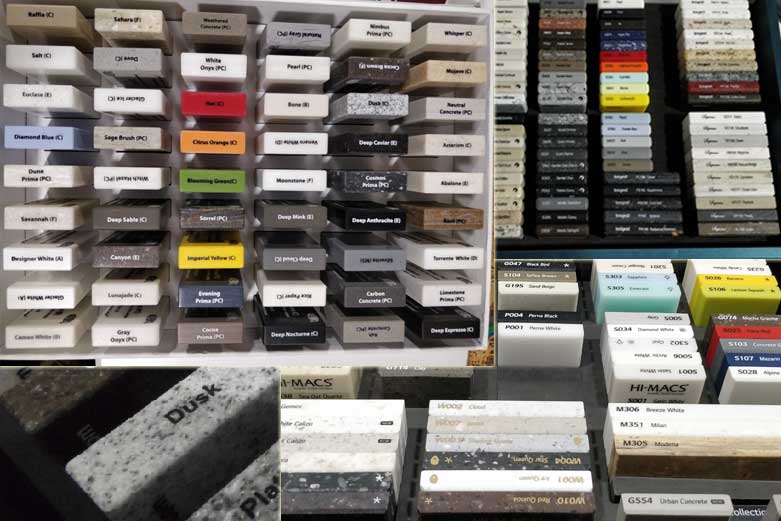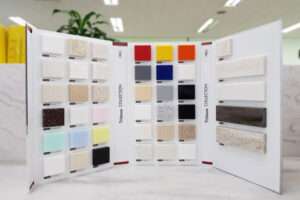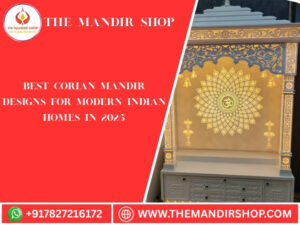Table of Contents
ToggleWhat Is Acrylic Solid Surface?
Acrylic solid surface sheets are made of a composite material that is made up of acrylic, pigment, and a small amount of mineral fillers. The acrylic is the primary component of the material, and it gives the sheets their strength and durability. The pigment is used to add color to the sheets, and the mineral fillers help to improve the strength and durability of the material.
Acrylic Solid surface is a man-made material usually composed of a combination of alumina trihydrate (ATH), acrylic, epoxy or polyester resins and pigments. It is most frequently used for seamless countertop installations. Acrylic Solid surface is a manufactured material most commonly used for seamless countertop installations, Temple, Bathroom Vanity Etc. It is frequently referred to as Corian®, a product developed by DuPont™ in 1964.
Acrylic Solid Surface can be readily cut, routed and sanded like wood and formed into countertops, shower walls, external cladding for buildings, signage and furniture where non-porosity and infrequent maintenance are highly valued. These are just a few of the many applications.
Acrylic Solid surface is made of acrylic resin, polyester resin or a combination of the two that is then combined with filler, color pigments and acrylic chips. This composition is most frequently extruded or poured as ½” thick sheets that are 30” x 144” and are the same color throughout their thickness.
In addition to being workable like hard wood, it can be heated and thermoformed into curved and molded shapes. It can also be printed on using dye-sublimation techniques that deposit the ink just below the surface so the image becomes permanent.
Acrylic solid surface sheets are a popular choice for many applications because they are durable, easy to clean, and available in a wide variety of colors and finishes. They are also relatively low-maintenance, and they can be repaired if they are scratched or damaged.
Here are some of the advantages of using acrylic solid surface sheets:
- Durability: Acrylic solid surface sheets are very durable and can withstand a lot of wear and tear. They are also resistant to scratches, stains, and heat.
- Easy to clean: Acrylic solid surface sheets are very easy to clean. They can be cleaned with a mild soap and water solution, and they do not require any special cleaning products.
- Variety of colors and finishes: Acrylic solid surface sheets are available in a wide variety of colors and finishes. This allows you to choose the perfect look for your project.
- Low-maintenance: Acrylic solid surface sheets are very low-maintenance. They do not require waxing or polishing, and they can be easily repaired if they are scratched or damaged.
Applications Of Acrylic Solid Surface









Acrylic Solid surface can be used in many ways. If you can imagine it, you can probably build it out of solid surface. Here are a few common applications:
Horizontal Surfaces: Among the many horizontal surface uses are kitchen and bath countertops, commercial food preparation areas, tables and desktops, reception desks, workstations, window sills, laboratory bench tops, bar tops, and flooring.
Vertical Surfaces: Vertical applications of solid surface include shower walls, wainscoting, wall cladding, bathroom partitions, exterior building cladding, and signs.
Industrial Product Design: Versatility and formability allow for unique creations such as custom sinks, shower pans, chairs and furniture, cabinetry, lamps and lighting, and back-lit artwork.
Residential Projects
Reimagine your home with our Tristone products ranging from sheet material and worktops to thermoformed sinks, bowls and basins, Bathroom Vanity & Temple for Home and Offices.
Commercial Projects
Acrylic Solid Surface non-porous acrylic surface can fend off bacteria and other harmful germs making it the perfect solution for commercial applications.
Advantages Of Solid Surface
Stain Resistant (Most Stains can be Wiped or Scrubbed Away)
Most surfaces can be marred, sometimes permanently, by such things as grease spots, blueberries, graffiti, makeup or lipstick, hair dye, shoe polish, or permanent marking pens. On solid surface, all of these blights can be removed with water or an abrasive cleaner.
Antimicrobial (Bacteria, Mold and Mildew Resistant)
Acrylic Solid surface will not support the growth of bacteria, which makes solid surface invaluable in healthcare settings like hospitals, doctors offices, gyms, hospices, and retirement homes. Not to mention kitchens and bathrooms.
NSF/ANSI Standard 51 Certified
The majority of solid surface brands carry this certification which means the material is safe for food contact for all types of food. That’s why it’s great for kitchen countertops.
Greenguard NSF Indoor Air Quality Certified
The majority of solid surface brands carry this certification, which means it does not outgas any of the roughly 300 substances that Greenguard deems harmful, and does not degrade the quality of indoor air.
SCS Certified Recycled Content (Many Brands Qualify for Leeds Points)
Using these select types of solid surface that qualify for recycled content shows that conserving natural resources is important to you and your projects.
Renewable (Easily Repair Scratches, Chips, Gouges or Cracks)



Light sanding will remove scratches, small chips, and scorches from cigarettes or extremely hot pots. Gouges and cracks may need the attention of a professional solid surface repairman.
Invisible Seams
Large surfaces require seams regardless of the material used. With solid surface, the seams are either invisible or remarkably hard to detect. This is not only good for aesthetics, but it also eliminates a place for crumbs, dirt, stains, and bacterial and other pathogens to get into. Shop for abrasives and adhesives.
Sealing and Painting NOT Required
If you think about that for a minute, it’s really remarkable and unburdening. You don’t need to reseal the surface every six months and you don’t need to worry that if you don’t, the grease will leak through and permanently stain the surface.
- No-finish coat means no need for applying a finish, sanding, and applying another coat or having paint booths or drying rooms and all the assorted equipment.
- No repainting means that when the surface becomes dingy or aged it can easily be fixed with a cleaner and some wiping or scrubbing instead of repainting or resurfacing.
More Dimensionally Stable Than Wood (No Shrinkage Cracks or Raised Grain)
The grain of unfinished wood rises when it gets wet or absorbs moisture. Even finished wood can dry out and crack. Although solid surface can slightly expand and contract from temperature changes, it does not crack or absorb moisture.
Thermoformable (Heat and Bend into Curves and Shapes)
In recent years, the solid surface industry has begun to leverage solid surface’s ability to become pliable when heated to around 300-350 degrees. Once it is in this state, it resembles a thick wet lasagna noodle. When you drape the “noodle” over an object, solid surface will conform to the shape and retain that shape when it cools.
Printable (Transfer Images and Text into the Surface)
The process called dye sublimation allows for the transfer of images and text to be embedded into the surface of solid surface. The technique involves heating the solid surface and then transferring the ink to the surface under a vacuum condition. The images and text are then permanently affixed in the pores of the solid surface. It can then be thermoformed, fabricated, and cleaned or sanded lightly.
Abundance of Colors, Patterns and Designs
Solid surface is available in a vast array of colors and patterns, for example:
- Infinite solid colors
- Small multicolored particulates like grains of sand embedded in the sheets
- Larger particulates such as found in granite
- Randomly veined with particulates variegated, swirled, and veined patterns with particles that do not repeat
These patterns are often inspired by nature, but then sometimes do not at all resemble nature and are whimsical. Some have swirls of metal shavings or strands of other materials. You can also have custom colors made to fit your designs by sending a sample to be matched.
Touch and Feel
Solid surface is not stone-cold, like concrete, quartz, and granite. It is smooth and “warm” and provides a forgiving hardness; when a glass is tipped over, it may not break. However, when dropped from a distance, glass will likely break.
Outdoor Applications
The lighter colors of solid surface show very little weather or UV impact after many years in outdoor applications such as signs, outdoor benches, and cladding for buildings. An added benefit of the material is that graffiti can be removed without changing the appearance of the surface.
Freezing and hot weather do not impact the material other than expansion and contraction. Over extended years, the more saturated and darker colors may show a white haze that can be washed or sanded away.
Resistant to Majority of Common Chemicals
Solid surface is not impacted by chemicals like ammonia, mild acids, and trisodium phosphates. However, nail polish remover, strong acids, and concentrated bleach will produce a hazing effect. Hazing can be removed with the use of a wet Scotchbrite® pad.
Frequently Asked Questions
What’s the best way to look after Solid Surface work surfaces in everyday use?
Simply clean the work surface with soap and water. Cleaning agents containing ammonia, for example glass window cleaning products provide a streak free surface. Dishwashing liquids are not ideal, they usually contain hand care substances and over a period of time can cause the formation of a patina, which has to be removed by a qualified fabricator Further detailed care instructions can be viewed in the chapter ‘Care Instructions’ on this website.
Is solid surfaces hygienic?
Yes, Solid Surface is a non-porous material with seamless joints where bacteria cannot permeate into the seams or the surface. Compared with other surface materials, such as laminates, tiles, granite, marble and similar products, all of which are porous, Solid Surface provides a designed worktop where dirt and germs cannot accumulate and provides a surface which is easily maintained. In addition, when an undermount Solid Surface sink is fitted, the seamless joint provides a complete hygienic surface which is easily cleaned.
What advantages does Solid Surface have in comparison with laminated boards?
Solid Surface is a non-porous material, if laminate boards are permeated by moisture the substrate will swell and de-laminate rendering the work surface useless. Laminate boards can also be damaged by indentations or cutting marks and unlike Solid Surface cannot be repaired.
Does Solid Surface have any particular advantages in comparison with tiles?
As compared to Solid Surface the main disadvantage is the porous grout seams with the inevitable growth of mildew / fungus or the black spores that easily form in the grout seams between the tiles, especially in the bathroom, shower areas which cannot be remove permanently by cleaning. Solid Surface allows the entire surface area to be installed without seams, even if decorative design elements are integrated, and because the product is non-porous mildew/ fungus and black spores cannot grow on the surface.
Can cutting and chopping tasks be performed directly on a Acrylic Solid Surface?
We would recommend that you do not cut or chop directly on to your Solid Surface work surface. The surface will show marks especially modern knives made from ceramic which are extremely sharp and hard. Your local fabricator will leave with you a cutting board made from off-cuts, it is very practical, it can be washed easily and it retains all the advantages of the Acrylic Solid Surface product.


